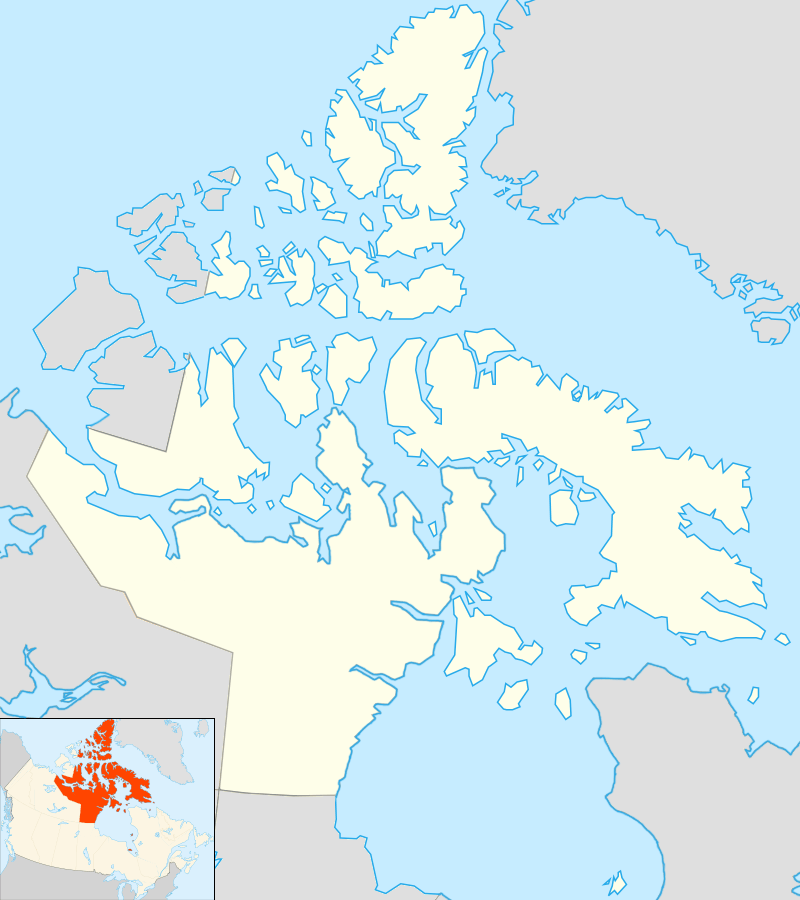Ferguson Lake (Kitikmeot Region)
| Ferguson Lake | |
|---|---|
 Location in Nunavut | |
| Location | southern Victoria Island, Kitikmeot, Nunavut |
| Coordinates | 69°25′N 105°15′W / 69.417°N 105.250°WCoordinates: 69°25′N 105°15′W / 69.417°N 105.250°W |
| Primary outflows | Ekalluk River |
| Basin countries | Canada |
| Surface area | 588 km2 (227 sq mi) |
| Surface elevation | 11 m (36 ft) |
| Islands | 8 km × 4 km (5.0 mi × 2.5 mi) |
| Settlements | Cambridge Bay, 50 km (31 mi) south |
| References | [1] |
Ferguson Lake (Inuinnaqtun: Tahiryuaq or Tahikyoak) is located on southern Victoria Island in the Kitikmeot Region of Nunavut, in northern Canada. It drains westward into Iqaluktuuq River (meaning "place of big fish") which is a segment of the Ekalluk River, 5 mi (8.0 km) from the northeastern side of Wellington Bay (Ekaloktok), on Dease Strait, Arctic Ocean[2] Ferguson Lake is the namesake of Constable Ferguson, a Royal Canadian Mounted Police member.[3]
Ferguson Lake has been characterized as "polar semi-desert". Its fauna includes willow-sedge meadows, Dryas uplands, and raised beaches. The narrow land area between Wellington Bay and Ferguson Lake funnels migrating Dolphin and Union caribou herd, making them easy prey for Inuit hunters. Muskox, Arctic hare, and ptarmigan also inhabit the area.[4] The lake itself contains Arctic char (iqalukpiit) and lake trout (ihuurayuit). These were the principal food sources for Copper Inuit who were predated by people of the Dorset culture through Thule culture as evidenced by Canadian Arctic archaeological sites on the banks of the lake, its river, and about 1 km north on the bay (Cadfael site).[5]
See also
References
- ↑ "Principal lakes, elevation and area, by province and territory". Statistics Canada. 2005-02-02. Retrieved 2015-03-11.
- ↑ Keith, Darren (n.d.). Life at Iqaluktuuq (PDF) (kitikmeotheritage.ca ed.). Yellowknife, NWT: Artisan Press Ltd. Retrieved 2008-01-24.
- ↑ Tologanak, Navalik (2007-08-20). "Traditional names still remain". Northern News Services Online. Retrieved 2008-01-24.
- ↑ Schaefer, James A.; Scott D. Stevens; François Messier (December 1996). "Comparative Winter Habitat Use and Associations among Herbivores in the High Arctic" (PDF). Arctic. ucalgary.ca. 49 (4): 387–391. doi:10.14430/arctic1215. Retrieved 2008-01-24.
- ↑ Brink, Jack (June 1992). "Anvil Boulders and Lithic Reduction on Southern Victoria Island, Northwest Territories" (PDF). Arctic. ucalgary.ca. 45 (2): 138–144. doi:10.14430/arctic1385. Retrieved 2008-01-24.